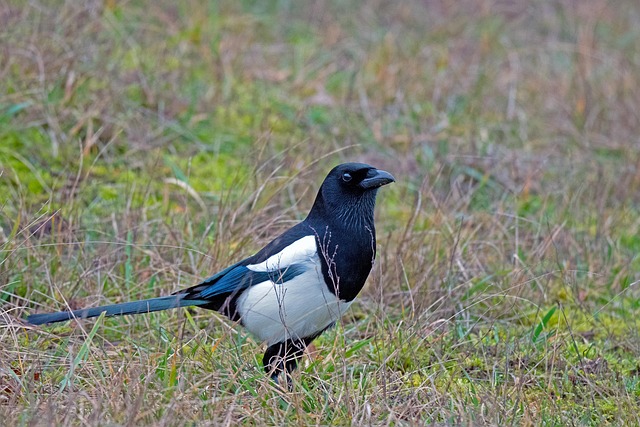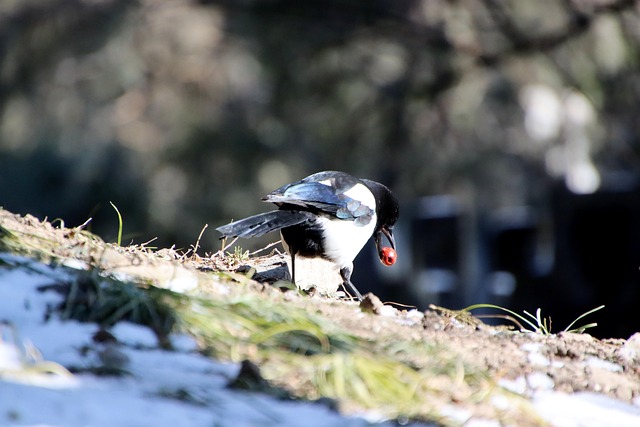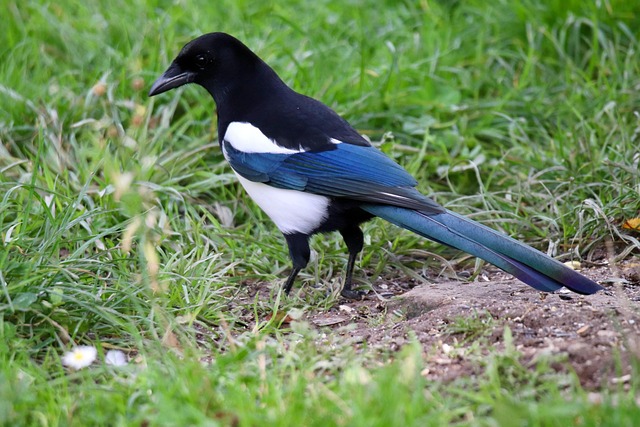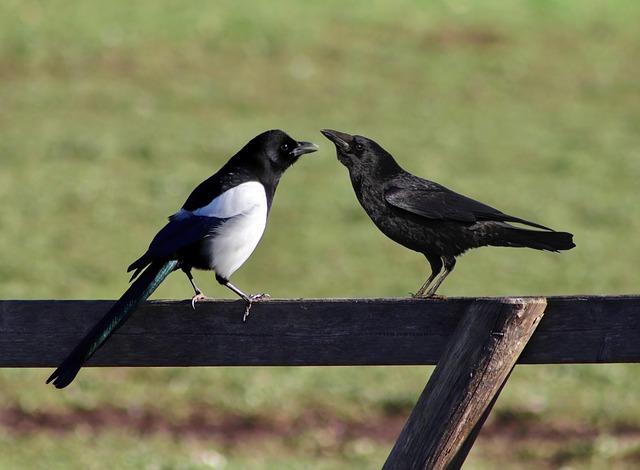Pica Pica: Of shiny things and Human Folklore
This isn’t a guide to hand-feeding or taming. It’s a practice in noticing. In challenging the stories we’ve inherited about who belongs and who threatens. To befriend a magpie is to meet the equinox in feathered form—black and white, wild and wise, keeper of thresholds.
With their bold black-and-white plumage and long, expressive tails, Eurasian magpies (Pica pica) are among the most recognisable birds in the British landscape. Members of the Corvidae family—kin to crows, jays, and ravens—magpies are known not only for their intelligence but for their presence in both myth and hedgerow.

Measuring up to 46 cm in length, with tails nearly as long as their bodies, they move with a kind of deliberate curiosity. Found across temperate regions of Europe, Asia, and western North America, magpies thrive in woodlands, meadows, farmland edges, and even urban parks—anywhere that offers a mix of trees for nesting and open ground for foraging. They are birds of the in-between: not quite wild, not quite tame, always watching.
What’s in a Name?
The magpie’s scientific name—Pica pica—is more than taxonomy. It’s an echo from Latin, where pica quite literally meant “magpie.” Centuries ago, humans had already noticed something distinctive in the bird’s behaviour: its erratic, seemingly indiscriminate appetite for all things odd. The name stuck—and from it grew another curious branch of language.
The medical condition pica, used to describe a compulsion to eat non-food items like soil, chalk, or coal, is rooted in that same Latin word. Why? Because magpies were thought to eat anything.

Shiny, strange, sometimes inedible—their foraging habits became a metaphor for disorder, and their name found its way into medical texts as early as the 16th century.
But like so many hand-me-downs from folklore, this one’s a little frayed at the edges. While magpies can be eclectic collectors, modern studies show they’re actually wary of unfamiliar objects. The idea of the magpie as thief or hoarder may be more myth than habit. Still, that myth gave us a word, and that word gave us a window into how deeply language can be shaped by the wild.
So in naming the bird Pica pica, Linnaeus wasn’t just cataloguing a species—he was echoing centuries of story. And in using that name for a disorder, early physicians were unknowingly carrying a feather of folklore into science.
The Myth of the Thief
For centuries, the magpie has carried the reputation of a thief—its name whispered alongside silver spoons, missing trinkets, and glinting mischief.
This image took flight not just in folklore, but in art and opera, most famously in Gioachino Rossini’s 1817 work La gazza ladra (The Thieving Magpie).

Based on a true story, the opera tells of a servant girl wrongly accused of stealing silver. She’s sentenced to death, only for the real culprit—a magpie—to be discovered at the last moment, its nest glittering with the missing items. The tale is melodramatic, yes, but it struck a chord: the idea that a bird could upend human justice, that something so small and wild could hold such sway.

Long Before the Overture: Magpie Lore in the Old Tongue
But the magpie’s reputation as a thief predates Rossini. In European folklore, it was often cast as a trickster—clever, unpredictable, and morally ambiguous. This archetype appears across cultures: the creature who disrupts order, who dances on the edge of mischief and wisdom. Magpies, with their sharp eyes and bold movements, seemed to embody this role effortlessly. They were birds that noticed—and in noticing, unsettled.
In some traditions, the magpie was a harbinger of mischief; in others, a symbol of duality. Its plumage—black and white, shadow and light—made it a living metaphor. Neither crow nor dove, it straddled the liminal space between opposites. This visual contrast invited projection: was it a thief or a sage, a nuisance or a messenger? The ambiguity became part of its power.
And so the myth endured.

Whether or not magpies truly steal, they have certainly stolen our imagination. They nest in our stories, perch in our superstitions, and flutter through our operas and rhymes. Their presence reminds us that nature is not always tidy or tame—and that sometimes, the creatures we mistrust are the ones most like us: curious, complex, and impossible to pin down.
Why It Matters: Seeing and Miss-seeing Nature
Stories are not just entertainment. They are lenses—sometimes clear, sometimes clouded—through which we view the living world. When we call a magpie a thief, we do more than describe behaviour. We assign motive. We moralise. We turn curiosity into crime.

This matters because perception shapes treatment. A bird seen as clever becomes a marvel; a bird seen as cunning becomes a nuisance. The same intelligence that earns admiration in a raven may earn suspicion in a magpie.
And so, folklore becomes a kind of ecological bias—one that influences conservation, policy, and even casual cruelty.
But stories can also be medicine. They can restore relationship. When we revisit old tales with new understanding, we don’t have to discard them—we can reweave them. The magpie doesn’t need to be stripped of myth to be respected. It can be both symbol and species, both metaphor and material presence.
To see clearly, we must learn to notice not just the creature, but the story we’ve draped over it. And then ask: Who told this tale? What did they fear? What did they love? In doing so, we begin to unpick the threads of miss-seeing, and stitch together a more reciprocal gaze.
Field Notes: Equinox Visitation
I never fail to see a magpie at the equinox.
Even when the date slips past me, one appears—watchful, present, unmistakable. Around this time, they seem more relaxed. Their young are grown, the urgency of feeding eased. They spend time with their mates, investigate the world with a kind of spacious curiosity. I see them more often. I feel seen.
Last autumn, I marked the equinox with a quiet ritual in the woods. My journal in hand. A cup of tea. A whispered intention. A magpie landed nearby, not startled, not demanding—just there. It felt like a nod from the threshold.

A reminder that balance is not passive. It’s something we meet, season by season.
They say “One for sorrow…”—a rhyme many of us learned without knowing why. But it may echo something true. Magpies often mate for life, staying close to their partners. So when we see one alone, especially in a season of endings, perhaps it is sorrow. Perhaps it’s a quiet grief, feathered and watchful. And yet, even in solitude, they arrive. They keep showing up.

Their black and white plumage—equal parts shadow and light—makes them perfect symbols of this turning. Day and night held in feathered symmetry. Not one or the other, but both. Not either/or, but both/and.
What the Magpie Reminds Me
Magpies are more than symbols. They are seasonal companions, mythic messengers, and behavioural mirrors. Their presence at the equinox—year after year—feels like a kind of covenant. A reminder to pause, to notice, to balance.
Folklore tells us “One for sorrow,” and perhaps that sorrow is real: a solitary bird, a lost mate, a quiet grief. But even in that, there is meaning. To see one is to be reminded that stories live in feathers, and that noticing is an act of care.

This piece is not a conclusion, but a threshold. The magpie stands at the hinge of the year, and so do we. May we meet the season with curiosity, with reverence, and with the kind of attention that turns observation into relationship.
Are you a Magpie Marveller too? Did something in this piece spark wonder or recognition? I’d love to hear your reflections in the comments below…
Magpies, with their black-and-white plumage and liminal presence, feel like the perfect emblems of the equinox. I’ve written more about that seasonal balance here, and if you’d like to explore their folklore across cultures, this piece from BrainWise Mind is a lovely companion.

Leave a Reply